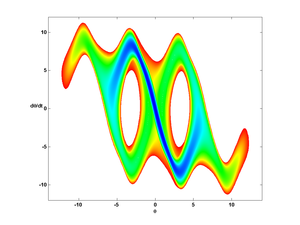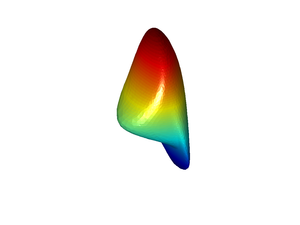Research
Below is a description of the research projects that I have been fortunate to work on with great collaborators: nonlinear controllability, numerical solutions to optimal control problems, invariant manifolds in control theory, spectral graph theory, networked dynamical systems. Software packages that I use in my research are: SciPy Python, NetworkX, nauty, Armadillo C++
Controllability of Networked Dynamical Control Systems
NSF ECCS Grant No. 1509966,
1700578
Networks are a useful tool to model complex dynamic behavior in many branches of science and engineering. A networked dynamical system is a collection of dynamic units (e.g. ODEs) that are able to communicate and share information only locally with neighboring systems. The shared information between systems can affect the dynamics of each individual unit and the global dynamics. The communication network between units determines a graph (as in graph theory) and an inherent problem is to determine in graph-theoretic terms how the graph structure affects global dynamic behavior. From a control-theoretic standpoint, one is interested in altering the free dynamics of the networked system to achieve a desired global task such as state transfer, synchronization, sensoring, etc. A very practical problem is to understand how to properly select only a subset of the units to act as controlling agents that will be used to accomplish the desired task. Although the property of controllability is mathematically generic, many real-world networks possess a high-level of structure such as symmetries, regularity, tree structures, etc. Such structures impose significant constraints on the selection of agents to control the overall network.
- C.O. Aguilar, B. Gharesifard, Laplacian controllability classes for threshold graphs, Linear Algebra and Its Applications, Vol. 471, pp. 575-586, 2015. (journal version)
- C.O. Aguilar, B. Gharesifard, Graph controllability classes for the Laplacian leader-follower dynamics, IEEE Transactions on Automatic Control, Vol. 60, No. 6, pp. 1611-1623, 2015. (journal version)
- C.O. Aguilar, B. Gharesifard, Almost equitable partitions and new necessary conditions for network controllability, Automatica, Vol. 80, pp. 25-31, 2017. (journal version)
- C.O. Aguilar, Joon-yeob Lee, Eric Piato, Barbara J. Schweitzer, Spectral characterizations of anti-regular graphs, Linear Algebra and Its Applications, Vol. 557, pp. 84-104, 2018. (journal version)
- C.O. Aguilar, Strongly uncontrollable network topologies, IEEE Transactions on Control of Network Systems, accepted, 2019.(journal version)
- C.O. Aguilar, M. Ficarra, N. Schurman, B. Sullivan, The role of the anti-regular graph in the spectral analysis of threshold graphs, Linear Algebra and Its Applications, Vol. 588, pp. 210-223, 2020. (journal version)
Hamilton-Jacobi PDEs
Both animations show the nonlinearity of HJ PDEs: self-intersection of the level sets and the formation of cusps on the level sets. In both cases, the value function looses differentiability but remains Lipschitz continuous. Possible projects in the future include developing robust numerical algorithms to deal with the aformentioned nonlinear effects and the presence of fast and slow dynamics. Another issue of interest involves the construction and/or incorporation of reliable adaptive algorithms to describe the local geometry of the level sets such as nearest neighbors information.
- C.O. Aguilar, A.J. Krener, High-order numerical solutions to Bellman's equation of optimal control, Proceedings of the American Control Conference, 2012, pp. 1832--1837. (proceedings version)
- C.O. Aguilar, A.J. Krener, Numerical solutions to the Bellman equation of optimal control, Journal of Optimization Theory and Applications, Vol. 160, No. 2, pp. 527-552, 2014. (journal version)
Periodic Center Manifolds
Invariant manifolds provide crucial insight into the overall
qualitative behavior of a dynamical system. For example, an
important feature of invariant manifolds is the simplification
resulting from reduction of dimension as they organize the
dynamics into smaller regions of the configuration space.
Recently, there has been an active effort in developing numerical
methods to compute (un)stable invariant manifolds of vector
fields using geodesic level sets, BVP continuation of
trajectories, computation of ``fat'' trajectories, and PDE
formulations. The computation of center manifolds has
received far less attention partially due to the subtle
properties regarding existence and regularity of center manifolds.
In control theory, the need to compute a center manifold
arises in the problem of stabilizing a reference trajectory of
the configuration variables. Through center manifold reduction,
the trajectory stabilization problem can be solved by computing
the solution φ to the invariant manifold PDE
- C.O. Aguilar, A.J. Krener, Piecewise smooth solutions to the nonlinear output regulation PDE, Proc. American Control Conference , 2011, pp. 1426-1427. (proceedings version)
- C.O. Aguilar, On the existence and uniqueness of solutions to the output regulator equations for periodic exosystems, Systems and Control Letters, 61, 702-706, 2012. (journal version)
- C.O. Aguilar, A.J. Krener, Patchy solution of a Francis-Byrnes-Isidori partial differential equation, International Journal of Robust and Nonlinear Control, Vol. 23, No. 9, pp. 1046-1061, 2013. (journal version)
Nonlinear Controllability
Given the controlled differential equation
- C.O. Aguilar, Local controllability of affine distributions Ph.D. thesis, Queen's University, defended Dec 2009.
- C.O. Aguilar and A.D. Lewis, Small-time local controllability for a class of homogeneous systems, SIAM Journal on Control and Optimization, Vol. 50, No. 3, pp. 1502-1517, 2012. (journal version)
- C.O. Aguilar, Local controllability of control-affine systems with quadratic drift and constant control-input vector fields, Proc. 51th IEEE Conf. Decision and Control, pp. 1877--1882, 2012. ( proceedings version)

